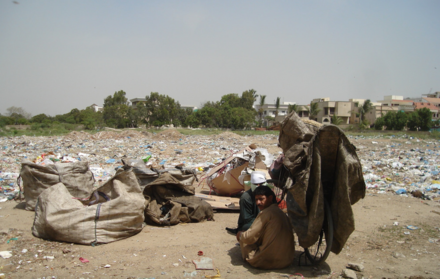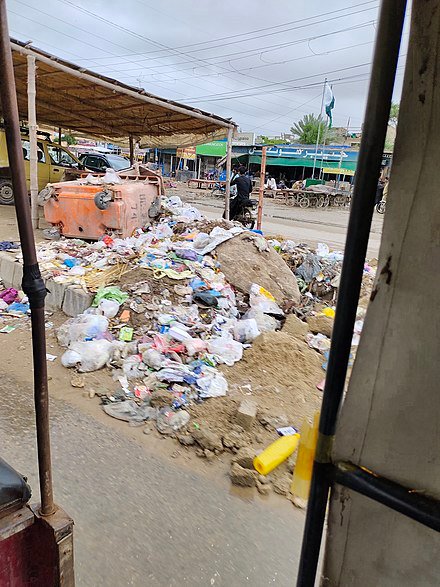Pollution in Pakistan air pollution, noise pollution and water pollution

Trash thrown in an empty plot in Karachi, Pakistan.

The picture shows trash lying in the centre of the street. The city has suffered significant harm due to poor administration. People leave trash on the highways, but the local authority never picks it up or even looks at it.
The World Bank report in 2013 stated that Pakistan's top environmental issues include air pollution, inadequate supply of uncontaminated drinking water, noise pollution and the health deterioration of urban and rural populations due to pollution. These environmental concerns not only harm Pakistani citizens but also pose a serious threat to the country's economy. The report also stated that the increase in industrialization, urbanization and motorization will inevitably worsen this problem.Pakistan holds the dubious distinction of being the world's third-most polluted country when it comes to air quality, compounding its environmental challenges. The swift pace of urbanization, coupled with population growth, presents further intricacies in this regard.
Water pollution
Pakistan is classified as a water stressed nation by the World Bank. There are seven main rivers that enter Pakistan from upper riparian states, including the Kabul River that enters from Afghanistan, and the Indus River, Jhelum River, Chenab River, Ravi River, and Sutlej River that enter from India. Among these, the Ravi and Sutlej are diverted in upstream India, for which consumptive use was awarded to India under the Indus Waters Treaty signed in 1960 by India and Pakistan. Canal networks from the Indus (main stem), Jhelum River, and Chenab River supply water throughout the agricultural plains in Punjab and in Sindh, while the rest of the country has very little access to other fresh water. Potential scarcity of water not only threatens Pakistan's economy but also poses a serious threat to the lives of millions of Pakistanis.
Lower flows due to the Indus Waters Treaty, as well as diversion to canals, means that lower dilution flows are available within the rivers of Pakistan. On the other hand, water pollution generation is increasing largely due to the growing economy and population, and an almost complete lack of water treatment. The sources for water pollution include the overuse of chemical fertilizers and pesticides, the dumping of industrial effluent into lakes and rivers, untreated sewage being dumped into rivers and the ocean, and contaminated pipelines being used to transport water.
The contamination of fresh drinking water makes it harder for people to find clean water supplies and increases the prevalence of waterborne diseases. Consequently, most of the reported health problems in Pakistan are either a direct or indirect result of polluted water.
45% of infant deaths are due to diarrhea and 60% to overall waterborne diseases.
According to researchers, Pakistan is projected to become the most water-stressed country in the region by the year 2040.
Noise pollution
The megacities of Pakistan, such as Karachi, Lahore, Islamabad and Rawalpindi, face the issue of noise pollution. The main source of this pollution is the traffic noise caused by buses, cars, trucks, rickshaws and water tankers. A study showed that on one of Karachi's main roads, the average noise level was around 90 dB and was capable of reaching about 110 dB. This is much higher than the ISO's noise level standard of 70 dB, which is not meant to be harmful to the human ear. However, the study also concluded that in Pakistan, "the traffic noise levels limit as laid down by National Environment Quality standards, Environmental Protection Agency is 85 dB"
This high level of noise pollution can cause auditory and non-auditory health issues. Auditory issues include the loss of auditory sensory cells; non-auditory health issues include sleep disturbance, noise and cardiovascular disease, endocrine response to noise and psychiatric disorder.
There are very few, vague laws and policies in regards to noise levels. There is no accountability, and while the federal and provincial environmental protection agencies receive dozens of complaints on noise pollution from the public, these agencies are unable to take action due to legal constraints and the absence of national noise level standards.
Air pollution
Air pollution is a growing environmental problem in most major cities of Pakistan. According to a World Bank report, "Karachi's urban air pollution is among the most severe in the world and it engenders significant damages to human health and the economy". The inefficient use of energy, an increase in the number of vehicles used daily, an increase in unregulated industrial emissions and the burning of garbage and plastic have contributed the most to air pollution in urban areas. According to a recent study, the Sindh Environment Protection Department claims that the average level of pollution in big cities is approximately four times higher than the World Health Organisation's limits. These emissions have detrimental effects, including "respiratory diseases, reduced visibility, loss of vegetation and an effect on the growth of plants".
One of the greatest contributors to air pollution is industrial activity. The inadequate air emission treatments and lack of regulatory control over industrial activity has contributed to the deterioration of ambient air quality in major cities. In addition, the common practice of burning massive amounts of solid waste, including plastic and rubber, on street corners by the public, releases toxic gases, which are extremely harmful for residents in the area.
In 2018, a young entrepreneur in Karachi, Abid Omar, launched the Pakistan Air Quality Initiative to monitor air quality in Pakistan's big cities. The project aims to increase the availability of air quality data in Pakistan and make citizens more aware of the health impacts of air pollution.
The US State Department has set up three high-quality air quality monitoring stations at three locations in Pakistan.
Specifically, studies have revealed the negative consequences air pollution can have on the welfare of those impacted. Studies have revealed how the constant fluctuation of particulate matter poses a major threat to Pakistan's citizens who are frequently exposes to harmful levels of air pollution. Suspended Particulate Matter, which has been linked to respiratory illnesses has been found in harmful quantities in Pakistan's major urban areas. Some strategies that can be used to effectively manage Pakistan's urban air pollution problems include the advancements to road design and improvement of transport sustainability, increased use of abatement policy by the Pakistani government, and a conversion to clean fuel energy alternatives like CNG.